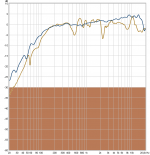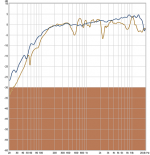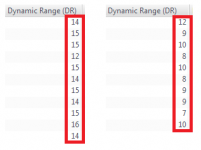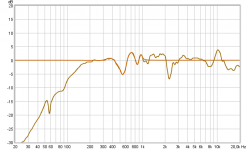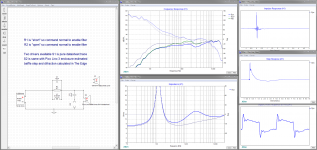I really don't know if you are going to get it. Stick the wrong driver in that and you'll have nothing below about (a guess?!?) 100hz.
Find something with a low VAS and a reasonably low FS. With a QTS of something in the 0.6 and up range. I did a "guess" simulation and the driver that looked least horrible was the Dayton ND90.
I think I prefer the Scanspeak more. Here is the 8414 kit in a transmission line.
Strassacker: Speaker Building, Components
I think I prefer the Scanspeak more. Here is the 8414 kit in a transmission line.
Strassacker: Speaker Building, Components
I quite like that. Recommend you build a Pico Lino 3. 🙂
.....The area that i highlighted is where the big difference between the 10F and the drivers i mentioned.....
How is it possible judge and postulate superior performance down low minus 30dB-60dB compared other speakers when at least two points hinders one to do that into subjective tests. Have no problem some postulate this or that setup sounds good but it goes wrong postulate "the ability to reproduce (not bury) low level detail" is superior compared other drivers for a device that from start have big distortion into minimum phase domain. Some or most that minumum phase domain distortion could maybe be repaired with complicated expensive passive networks or upstream analog or digital correction but that is not the case for postulations, and no prove is ever shown any where by measurements at design axis or listening position these superior subjective claims is real. At same odds is against FF85WK having Sd area of 28 sq cm / 0,35mm Xmax / rated input at 5 watt verse 10F/8424 Sd area 36 sq cm / 2,6mm Xmax / rated input at 15 watt. Other point that is against subjective postulations is not many tracks have real dynamic range so low that one is able to state the difference down there.
How can dark marked area minus 30-60dB be superior especially for drivers FF85wKen, Alpair 7.3eN, A7 MOAP, A5.2eN, A6PeN verse rest of worlds produced drivers when first wave we hear is response at the top and there is big minimum phase domain distortion for example FF85WK verse 10F/8424 to start with:
Find this plot in higher resolution as attachement-1.
Here is select plugged minimum phase distortion in area 300-1000Hz for FF85WK compared clean speaker input and clear show a veil of tails especially present minus 30-60dB. Those sound is not present in upstream signal and a pure distortion looking input relative to output and probably what the postulations is all about, but even if it wasn't that case those veil of distortion tails will hinder one to focus the area down there because of masking. This was for a select area 300-1000Hz, there is more IRR distortion happening for FF85WK above 1kHz area that will add more masking veils:
Find this plot in higher resolution as attachement-2.
Think not many tracks have real dynamic range so low that to postulate about "the ability to reproduce (not bury) low level detail" down at minus 30-60dB range. Two CD tracks analyzed here is TRACY CHAPMAN album with same title and EVA CASSIDY album SONGBIRD:
Find this analyze with more details as attachement-3.
Select plugged minimum phase distortion in area 300-1000Hz for FF85WK used for research this post:
Attachments
Last edited:
How can dark marked area minus 30-60dB be superior especially for drivers FF85wKen, Alpair 7.3eN, A7 MOAP, A5.2eN, A6PeN verse rest of worlds produced drivers
I was only comparing them to the stock 10F (i expect it will get better with treatment like the others).
dave
I think I prefer the Scanspeak more. Here is the 8414 kit in a transmission line.
http://www.lautsprechershop.de/hifi/pico_lino_3_en.htm]Strassacker: Speaker Building, Components[/url]
I'm intrigued by this design, but what's the crossover for?
but what's the crossover for?
From what it says, it is th esame trick i learned about in the late '70s from work Henry Kloss did… the filter acts to supress a wide range of frequencies to make the speaker flatter.
dave
I'm intrigued by this design, but what's the crossover for?
For fun did some model in XSim using SS datasheet curves, gray trace is datasheet, green trace is datasheet times baffle and diffraction prediction from The Edge program, blue trace is same as green with R1/C1/L1 filter turned on. Find XSim file attached into zip folder.
Attachments
I was only comparing them to the stock 10F (i expect it will get better with treatment like the others).
dave
Ha ha you impossible to discuss with in more normal way be it objective or subjective we all just rookies and use cheap TV drivers plus our lab gear is flawed and useless but thanks posting more shop voodoo.
I think the error the OP makes, is to try to get the sound of a coaxial (The LS50) with a small fullrange. Small fullrange will never give a solid bass, they are ment to be used with a sub in a WAW config. If you want a solid bass, you need a much bigger driver.
I've use the 6" Mark Auido 10M gen 3 (the diagram is actually only a 5.5") in different style cabinets (ported, sealed and TL), and even that driver does not give a solid defined bass in those. You can get a deep bass out of it with a ported box tuned low and on low power, but it won't be much defined or punchy. That's why i use it now with a sub in waw config.
The LS50 uses a dual concentric coaxial (2 drivers in one), wich gives you a wider frequencyrange possible, and rely on a lot of electronics inside the box to eq the right sound of it. I don't think you can do that with a small fullrange in a TL.
I've use the 6" Mark Auido 10M gen 3 (the diagram is actually only a 5.5") in different style cabinets (ported, sealed and TL), and even that driver does not give a solid defined bass in those. You can get a deep bass out of it with a ported box tuned low and on low power, but it won't be much defined or punchy. That's why i use it now with a sub in waw config.
The LS50 uses a dual concentric coaxial (2 drivers in one), wich gives you a wider frequencyrange possible, and rely on a lot of electronics inside the box to eq the right sound of it. I don't think you can do that with a small fullrange in a TL.
6" Mark Auido 10M gen 3
A 5.25” driver (with a big bezel). In the right box these can produce significant bass, but cone size limits the amount you can generate.
If one want sreally solid, really low, really impactful bass in any but a small room, going to some sort of WAW configuration gets you bass & volume usually only seen in better multiway, but still with the magic of a FR.
One can always start with a FR and later add woofers if you find the need.
dave
For mini desktop setup with a 10" subwoofer to augment above 90hz.
Will 10f/8424g02-4 work in a small transmission line?
cabinet as narrow as possible and flat response down to 100hz?
Will 10f/8424g02-4 work in a small transmission line?
cabinet as narrow as possible and flat response down to 100hz?
Will 10f/8424g02-4 work in a small transmission line?
From my experience, poorly i expect.
dave
No matter what you do getting this driver to go below 125 Hz is a struggle. Scan calls is a MR, but people use it as a FR, better as a midTweeter where ony the weak — but very smooth — top end is a bother. Its little brother (8414) can reach much lower.
dave
dave
It would be interesting to try these 2 scans in Frugel-Horn Lite which should be close as you’ll get to maximum bass.
dave
dave
Dave,
those look nice but I am looking for a pair of mini DESKTOP speakers based on the 10f/8424g02, augmented by a sub above 100hz.
So I'd like a flat response and max output down to about 110hz from the 10f.
Based on that requirement (NOT lowest possible bass extension), any thoughts on a compact box -- bass reflex or small TL?
those look nice but I am looking for a pair of mini DESKTOP speakers based on the 10f/8424g02, augmented by a sub above 100hz.
So I'd like a flat response and max output down to about 110hz from the 10f.
Based on that requirement (NOT lowest possible bass extension), any thoughts on a compact box -- bass reflex or small TL?
I would just use a small 2 liter sealed box (like a Dagger) and go with the 10F/8414 to get to about 150Hz. No vents needed and it will sound tight and clean.
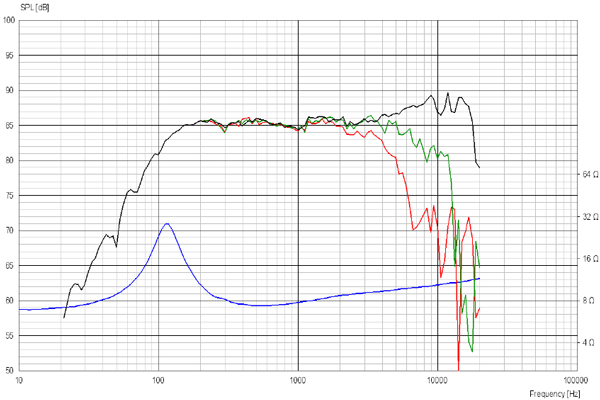
The fs is too high and the Qts of the 10F/8424 is too low to be used in a transmission line down to 100Hz. It really is for sealed or front horn loading.

The fs is too high and the Qts of the 10F/8424 is too low to be used in a transmission line down to 100Hz. It really is for sealed or front horn loading.
- Home
- Loudspeakers
- Full Range
- Scanspeak 10f/8424 or Vifi NE123w for small TL box?
